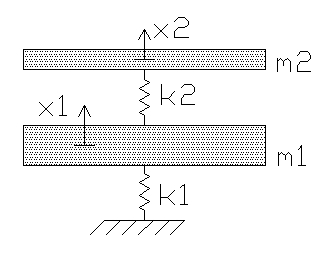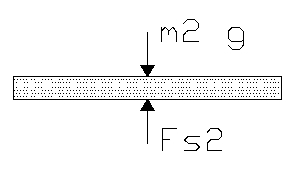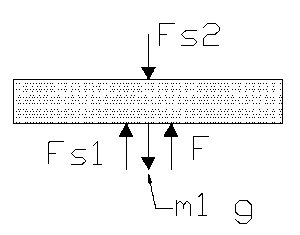Coupled Oscillator: Coupled Mass-Spring System with Input: Difference between revisions
Jump to navigation
Jump to search
No edit summary |
No edit summary |
||
| (One intermediate revision by the same user not shown) | |||
| Line 18: | Line 18: | ||
<math>k_2 = 80000 \frac{N}{m}</math> |
<math>k_2 = 80000 \frac{N}{m}</math> |
||
Let the initial conditions be zero for the time being. |
|||
| Line 100: | Line 97: | ||
\begin{bmatrix} |
\begin{bmatrix} |
||
0 & 1 & 0 & 0 \\ |
0 & 1 & 0 & 0 \\ |
||
\frac{-k_1}{m_1} & 0 & \frac{k_2}{m_1} & 0 \\ |
\frac{-k_1}{m_1}-\frac{k_2}{m_1} & 0 & \frac{k_2}{m_1} & 0 \\ |
||
0 & 0 & 0 & 1 \\ |
0 & 0 & 0 & 1 \\ |
||
\frac{k_2}{m_2} & 0 & \frac{-k_2}{m_2} & 0 |
|||
\end{bmatrix} |
\end{bmatrix} |
||
Latest revision as of 16:25, 13 December 2009
Setup State Space Equation
Problem Statement
Find an input function such that the lower mass, , is stationary in the steady state. Find the equation of motion for the upper mass, .
The use of one spring between the masses is just a simplification of a multi-spring system, so the possibility of being off-kilter is neglected and just the vertical forces are considered.
Initial Conditions and Values
Force Equations
Sum of the forces in the x direction yields
For
Since
And for
Since
Where is the input force
State Space Equation
The general form of the state equation is
Where denotes a matrix and denotes a vector.
Let , , , and be the state variables, then



























